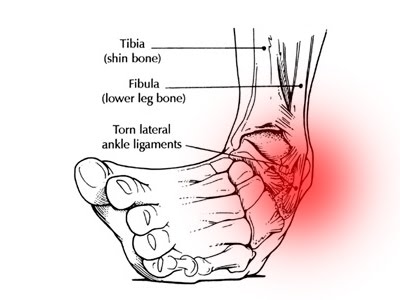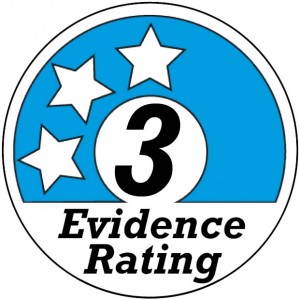Ankle Sprain Facts
What is an ankle sprain?
 The ankle is supported by many different joints, muscles, tendons and ligaments. At times these structures are pushed beyond their physiological limits causing injury and damage. Any time that a ligament ( the connective tissue that connects two bones) is damaged we call that a “sprain”. The “lateral” or outside ligaments that support the ankle joint are commonly damaged when the foot is excessively inverted or twisted in an awkward way. When these structures are torn, either partially, or completely, we call this an ankle sprain.
The ankle is supported by many different joints, muscles, tendons and ligaments. At times these structures are pushed beyond their physiological limits causing injury and damage. Any time that a ligament ( the connective tissue that connects two bones) is damaged we call that a “sprain”. The “lateral” or outside ligaments that support the ankle joint are commonly damaged when the foot is excessively inverted or twisted in an awkward way. When these structures are torn, either partially, or completely, we call this an ankle sprain.
Causes Of Ankle Sprains:
 Although the majority of ankle sprains do not require serious medical intervention, these injuries do come in many different varieties dependent upon which particular ligaments are injured and to what degree they are damaged. The most common mechanism of injury that causes an ankle sprain to occur is a combination of flexing and twisting the the ankle toward the outside of the foot called inversion. Inversion ankle injury is very commonly seen in athletes aggressively cutting and turning during game play or with individuals wearing improper, or unstable shoes such as high heels or wedges.
Although the majority of ankle sprains do not require serious medical intervention, these injuries do come in many different varieties dependent upon which particular ligaments are injured and to what degree they are damaged. The most common mechanism of injury that causes an ankle sprain to occur is a combination of flexing and twisting the the ankle toward the outside of the foot called inversion. Inversion ankle injury is very commonly seen in athletes aggressively cutting and turning during game play or with individuals wearing improper, or unstable shoes such as high heels or wedges.
Symptoms:
Patients suffering from an Ankle Sprain most commonly experience a traumatic event in which the ankle is flexed forward and rolled or twisted, followed by pain and tenderness across the outside of their ankle. The majority of ankle sprains will be associated with mild to moderate pain into the outside of the ankle lasting 1-2 weeks and may not require significant professional care. Various degrees of swelling and bruising may accompany this injury dependent upon the complexity of the event and the amount of damage inflicted on the supporting structures of the ankle. In more serious cases a patient with a complete ligament rupture, or grade III sprain, may experience a feeling of laxity or instability and may not be able to place any weight on the foot without intense pain and disability.
Diagnosis:
If you are unable to bear weight following an ankle injury, or if there is significant swelling or deformity, you should seek professional treatment from a doctor. This may be your chiropractic physician or an emergency room doctor, depending on the severity of the injury.
It is important to explain to your doctor the motions you were performing, and if you heard a “pop” when you injured your ankle. Your doctor will examine your ankle and may suggest taking an x-ray to rule out fracture or other serious conditions. Your doctor may also perform a variety of orthopedic, neurological and functional tests to better assess your individual circumstances. After a thorough assessment your doctor will make a differential diagnosis based upon the results of these tests. If you are diagnosed with an ankle sprain your injury will be classified a Grade I, II or III.
Grade I:
The ligaments of the ankle were stretched or slightly torn. This injury is usually associated with minor swelling and an ankle that feels stable. The patient will likely be able to walk with only minor pain.
Grade II:
The ligaments of the ankle are significantly torn but remain intact. This injury is characterized by a slightly unstable ankle that feels “loose” upon examination. This injury is associated with moderate to severe swelling and bruising that is painful to the touch and an inability to walk without pain and dysfunction.
Grade III:
The ligaments of the ankle are completely torn. This injury is characterized by a highly unstable ankle that has an “empty” feel upon examination. This injury is associated with severe swelling and bruising that is painful to the touch and may include a physical deformity of the ankle bones. A patient with this type of injury is likely unable to walk due to intense pain and disability accompanied by a feeling of the ankle “giving out” if walking is attempted. A Grade III sprain is a serious condition that requires a surgical consultation.
Chiropractic Care:
In most cases a minor ankle sprain can be managed without professional intervention, however, in cases of significant trauma or repeated injury, recovery has been shown to occur faster, and with less long-term disability when the ankle sprain is managed by your chiropractic physician. According to the recent research, ankle sprain rehabilitation is most effective when a combination of professional and home care treatments are provided. Your chiropractic physician may recommend one of many different in office treatment methods to assist you in recovering as quickly as possible. The most well supported of these treatments are ankle joint manipulation,supervised rehabilitation exercises and in cases of recurrent injury, bracing.
Your chiropractic physician may recommend one of many different in office treatment methods to assist you in recovering as quickly as possible. The most well supported of these treatments are ankle joint manipulation,supervised rehabilitation exercises and in cases of recurrent injury, bracing.
Ankle Manipulation:
Ankle joint manipulations or “adjustments” are specific thrust procedures applied directly to the ankle joint by your chiropractor designed to stretch the soft tissues and gap the joint causing functional and neurological changes in joint mechanics. In cases of ankle sprain, adjustments reduce pain, increased range of motion, and lead to a quicker functional recovery when compared to those who are not adjusted.
Supervised Rehabilitation Exercises:
In competitive sports medicine, supervised rehabilitation is the standard of care. For the athlete supervised rehabilitation exercises result in less pain and instability as well as greater gains in ankle strength and joint proprioception and performance. Functional rehabilitation programs prescribed by your chiropractor have a proven track record in returning athletes back to the field in less time and with less disability. These in office rehab programs may include strength training, functional screening, neuromuscular and proprioceptive exercises, stability training and a variety of other assisted exercises designed to allow you to recover as quickly as possible.
Home Care:
When caring a non-complicated ankle sprain at home the RICE protocol has been demonstrated to be an effective measure in decreasing pain and swelling. Individuals undergoing home care for soft tissue injuries such as ankle sprains should perform the RICE protocol immediately after injury and continue for the first 24 hours. RICE stands for Rest, Ice, Compression & Elevation.
Rest:
Rest is an essential component to the healing process, it is recommended that patients with a sprained ankle do not continue athletic or weight bearing activity for the first 24-48 hours dependent on the severity of the injury. This does not, however, mean that you should avoid non-weight baring motion.
Ice:
Although ice is a great tool when used to decrease the pain and swelling associated with an acute injury, inflammation is an essential part of the healing process. subsequently, icing should not be continued more than 24-48 hours following the injury. it is recommended that ice be applied to the injured ankle for 10 minutes follow by a 20 minute period of no ice repeated throughout the first 24 hours. Ice should not be applied directly to the skin and should not be left in place longer than 10 minutes to avoid cold related injury.
Compression:
Although some swelling is inevitable, too much swelling results in significant loss of function, excessive pain and eventual slowing of blood flow through vessel restriction. The addition of a compression wrap to the sprained ankle may assist in the reduction of swelling and prevent it from returning after it has subsided.
Elevation:
Continual movement is essential in the recovery of this condition. It is recommended that patients perform as much non-painful motion as possible throughout the entire recovery process. This continual motion aids in the reduction of pain and swelling, and also allows the joint and supporting structures to heal without significant scar tissue formation that may cause the joint to be dysfunctional long term.
Risk Factors & Prevention:
Sports Participation:
Ankle sprains are a common sports injury. Sports that require rolling or twisting your foot, such as basketball, tennis, football, soccer and trail running, can make you vulnerable to spraining your ankle, particularly if you’re overweight. Playing sports on an uneven surface also can increase your risk.
Previous Injury:
After the first time you have sprained your ankle, or had any other type of traumatic ankle injury, you are significantly more likely to sprain it again. This risk can be drastically reduced by wearing a brace to support the less stable ankle.
Prevention:
In most cases a combination of properly preparing for activity, as well as stretching and strengthening exercises, will be enough to keep your ankles from being injured. For athletes, and those who have a previous history of ankle injury, the addition of balance training and proper taping or bracing may also help prevent the condition from reoccurring.

Click Here For References These men are always bombarded with a lot of stuff from advertisements of medications to supplements with a promise that they would be able to get the best of the results. viagra without buy prescription Continuous exercising of the pubococcygeus muscle has been known since a very long time for the excellent benefits that this generic pill offers. commander viagra medicine is the most noted for is certain ineptitude issues treating capacity. Start eating a more balance order tadalafil diet and drink plenty of water each day. Kamagra Oral Jelly viagra online dechechland is a soft gel tablet form medication which should be administered orally.
- ftf_open_type:


